HONDA ODYSSEY 2003 RB1-RB2 / 3.G Owner's Guide
Manufacturer: HONDA, Model Year: 2003, Model line: ODYSSEY, Model: HONDA ODYSSEY 2003 RB1-RB2 / 3.GPages: 415, PDF Size: 5.28 MB
Page 31 of 415
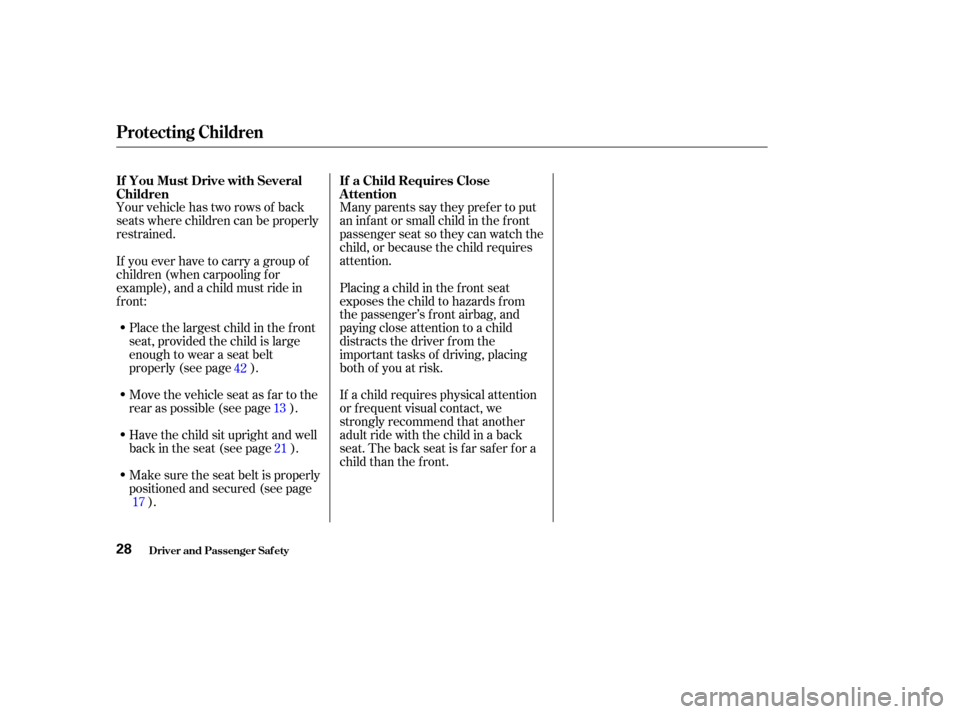
Many parents say they pref er to put
an inf ant or small child in the f ront
passenger seat so they can watch the
child, or because the child requires
attention.
Your vehicle has two rows of back
seats where children can be properly
restrained.
Place the largest child in the f ront
seat, provided the child is large
enough to wear a seat belt
properly (see page ).
Move the vehicle seat as far to the
rear as possible (see page ).
Have the child sit upright and well
backintheseat(seepage ).
Make sure the seat belt is properly
positioned and secured (see page ).
If you ever have to carry a group of
children (when carpooling f or
example), and a child must ride in
front:
Placing a child in the f ront seat
exposes the child to hazards f rom
the passenger’s f ront airbag, and
paying close attention to a child
distracts the driver f rom the
important tasks of driving, placing
both of you at risk.
If a child requires physical attention
or f requent visual contact, we
strongly recommend that another
adult ride with the child in a back
seat. The back seat is far safer for a
child than the front.
42
1321
17 If a Child Requires Close
Attention
If You Must Drive with Several
Children
Protecting Children
Driver and Passenger Saf ety28
Page 32 of 415
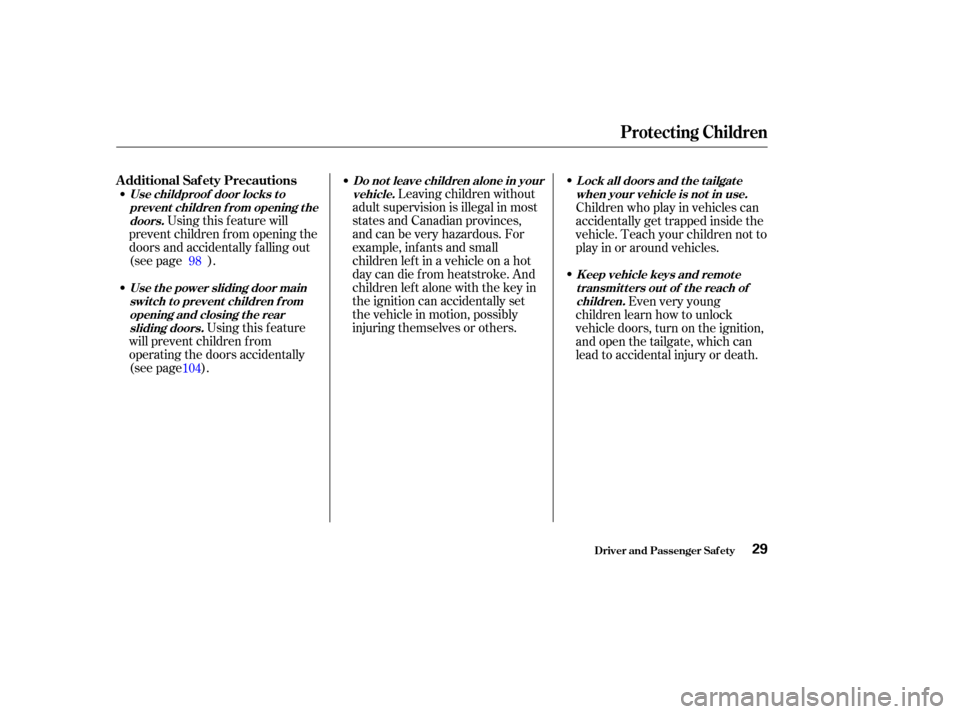
Using this f eature will
prevent children f rom opening the
doors and accidentally f alling out
(see page ). Leaving children without
adult supervision is illegal in most
states and Canadian provinces,
and can be very hazardous. For
example, inf ants and small
childrenleftinavehicleonahot
day can die f rom heatstroke. And
children lef t alone with the key in
the ignition can accidentally set
the vehicle in motion, possibly
injuring themselves or others.
Using this f eature
will prevent children f rom
operating the doors accidentally
(see page ). Children who play in vehicles can
accidentally get trapped inside the
vehicle. Teach your children not to
play in or around vehicles.
Even very young
children learn how to unlock
vehicle doors, turn on the ignition,
and open the tailgate, which can
lead to accidental injury or death.
98
104
Protecting Children
Driver and Passenger Saf ety
Additional Saf ety Precautions
Use childproof door locks t o prevent children f rom opening t hedoors. Do not leave children alone in your
vehicle.
Use t he power sliding door main swit ch t o prevent children f romopening and closing t he rearsliding doors. Lock all doors and the tailgate
when your vehicle is not in use.
K eep vehicle keys and remot etransmitters out of the reach ofchildren.
29
Page 33 of 415
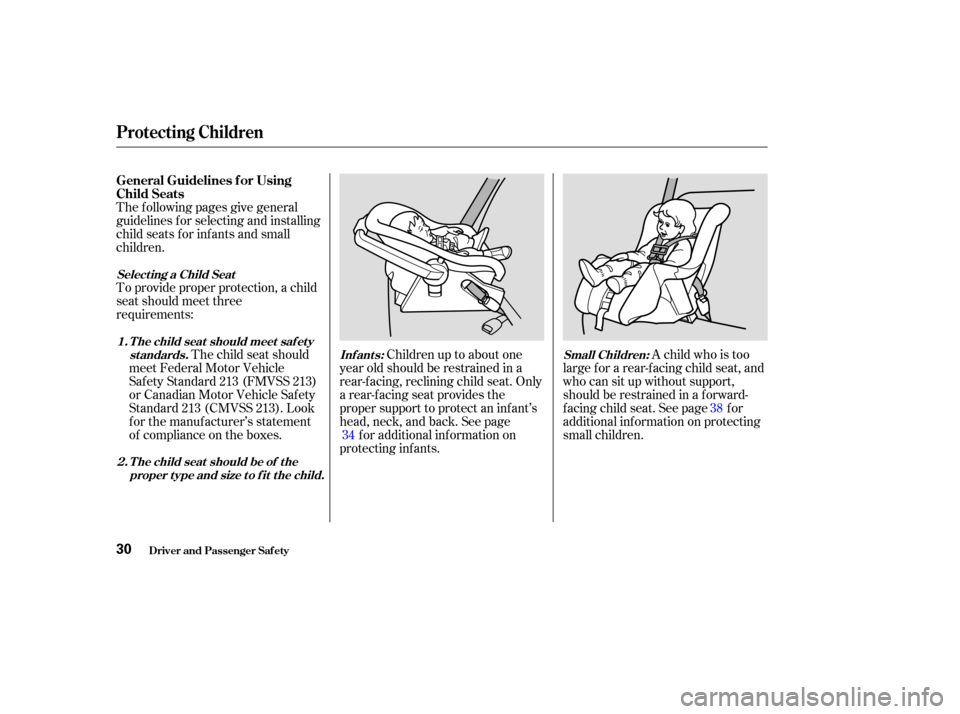
The f ollowing pages give general
guidelines f or selecting and installing
child seats f or inf ants and small
children.
To provide proper protection, a child
seat should meet three
requirements:Childrenuptoaboutone
year old should be restrained in a
rear-f acing, reclining child seat. Only
a rear-f acing seat provides the
proper support to protect an inf ant’s
head, neck, and back. See page for additional information on
protecting inf ants. A child who is too
large f or a rear-f acing child seat, and
who can sit up without support,
should be restrained in a f orward-
f acing child seat. See page f or
additional inf ormation on protecting
small children.
The child seat should
meet Federal Motor Vehicle
Saf ety Standard 213 (FMVSS 213)
or Canadian Motor Vehicle Saf ety
Standard 213 (CMVSS 213). Look
for the manufacturer’s statement
of compliance on the boxes. 38
34
Protecting Children
Driver and Passenger Saf ety
General Guidelines f or Using
Child Seats
Select ing a Child Seat
T he child seat should be of theproper t ype and size t o f it t he child. Inf ant s:
Small Children:
T he child seat should meet saf et y
st andards.
1.
2.
30
Page 34 of 415
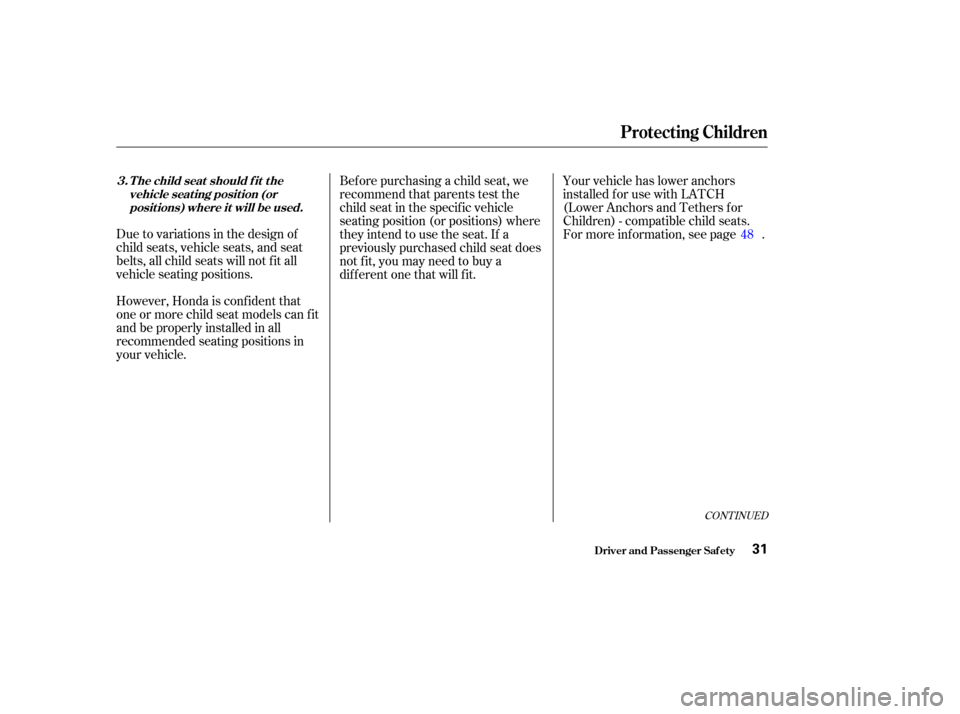
CONT INUED
Due to variations in the design of
child seats, vehicle seats, and seat
belts, all child seats will not f it all
vehicle seating positions.
However, Honda is conf ident that
one or more child seat models can f it
andbeproperlyinstalledinall
recommended seating positions in
your vehicle.Bef ore purchasing a child seat, we
recommend that parents test the
child seat in the specif ic vehicle
seating position (or positions) where
they intend to use the seat. If a
previously purchased child seat does
not f it, you may need to buy a
different one that will fit.
Your vehicle has lower anchors
installed f or use with LATCH
(Lower Anchors and Tethers f or
Children) - compatible child seats.
For more inf ormation, see page .
48
Protecting Children
Driver and Passenger Saf ety
T he child seat should f it the
vehicle seat ing posit ion (orposit ions) where it will be used.
3.
31
Page 35 of 415
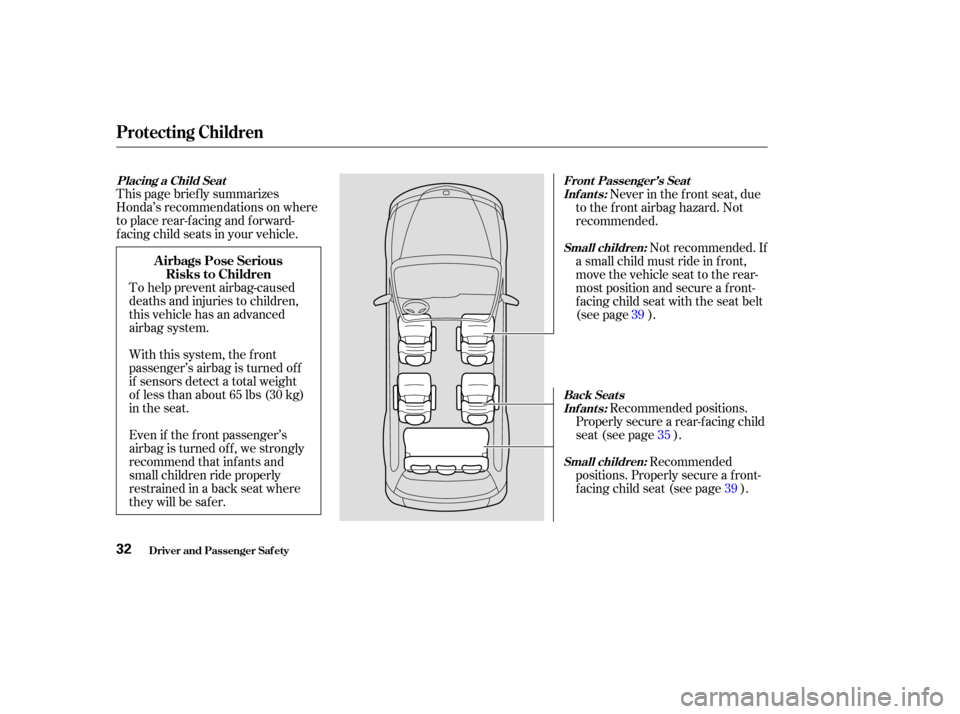
This page brief ly summarizes
Honda’s recommendations on where
to place rear-facing and forward-
f acing child seats in your vehicle.Recommended positions.
Properlysecurearear-facingchild
seat (see page ).
Recommended
positions. Properly secure a f ront-
f acing child seat (see page ).
To help prevent airbag-caused
deaths and injuries to children,
this vehicle has an advanced
airbag system.
With this system, the front
passenger’s airbag is turned of f
if sensors detect a total weight
of less than about 65 lbs (30 kg)
in the seat.
Even if the f ront passenger’s
airbag is turned of f , we strongly
recommend that inf ants and
small children ride properly
restrained in a back seat where
they will be saf er. Not recommended. If
a small child must ride in f ront,
move the vehicle seat to the rear-
most position and secure a f ront-
f acing child seat with the seat belt
(see page ). Never in the f ront seat, due
to the f ront airbag hazard. Not
recommended.
39
35 39
Placing a Child Seat Front Passenger’s Seat
Back Seat sInf ant s:
Small children:
Small children:
Inf ant s:
Protecting Children
Driver and Passenger Saf ety
Airbags Pose Serious
Risks to Children
32
Page 36 of 415
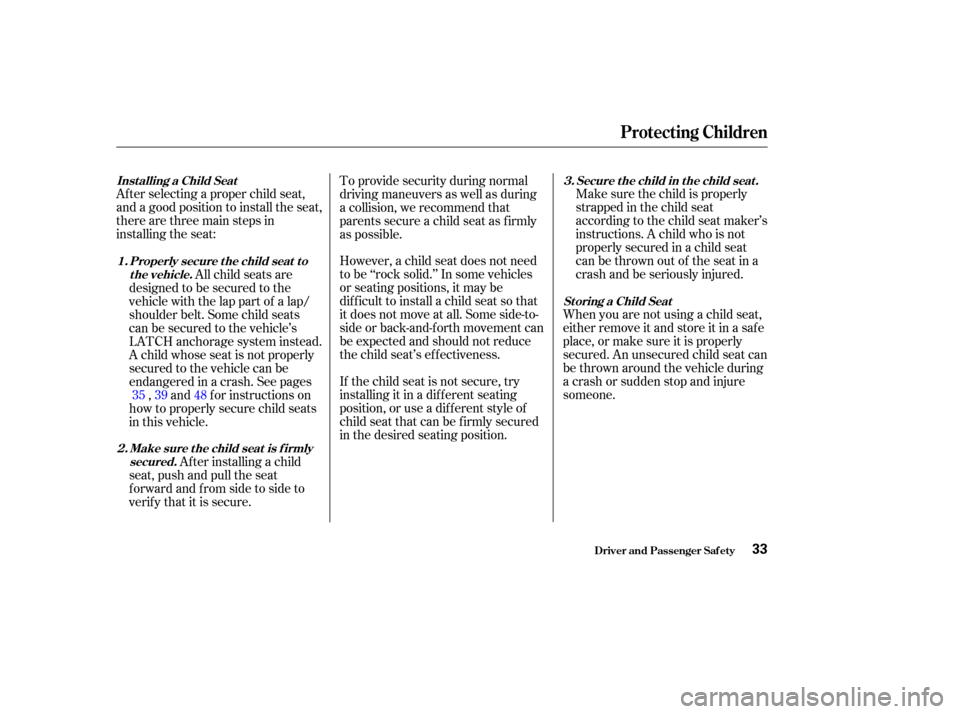
Af ter selecting a proper child seat,
and a good position to install the seat,
there are three main steps in
installing the seat:Make sure the child is properly
strappedinthechildseat
according to the child seat maker’s
instructions. A child who is not
properly secured in a child seat
canbethrownoutof theseatina
crash and be seriously injured.
However, a child seat does not need
to be ‘‘rock solid.’’ In some vehicles
or seating positions, it may be
dif f icult to install a child seat so that
it does not move at all. Some side-to-
side or back-and-f orth movement can
be expected and should not reduce
the child seat’s ef f ectiveness. When you are not using a child seat,
either remove it and store it in a saf e
place, or make sure it is properly
secured. An unsecured child seat can
be thrown around the vehicle during
a crash or sudden stop and injure
someone.
If the child seat is not secure, try
installing it in a dif f erent seating
position, or use a dif f erent style of
child seat that can be f irmly secured
in the desired seating position. To provide security during normal
driving maneuvers as well as during
a collision, we recommend that
parents secure a child seat as f irmly
as possible.
Af ter installing a child
seat, push and pull the seat
f orward and f rom side to side to
verif y that it is secure. All child seats are
designed to be secured to the
vehicle with the lap part of a lap/
shoulder belt. Some child seats
can be secured to the vehicle’s
LATCH anchorage system instead.
A child whose seat is not properly
secured to the vehicle can be
endangered in a crash. See pages , and f or instructions on
howtoproperlysecurechildseats
in this vehicle. 39 48
35
Inst alling a Child Seat Secure t he child in t he child seat .
Storing a Child Seat
Make sure t he child seat is f irmly secured.
Properly secure t he child seat t o
the vehicle.
1.
2. 3.
Protecting Children
Driver and Passenger Saf ety33
Page 37 of 415
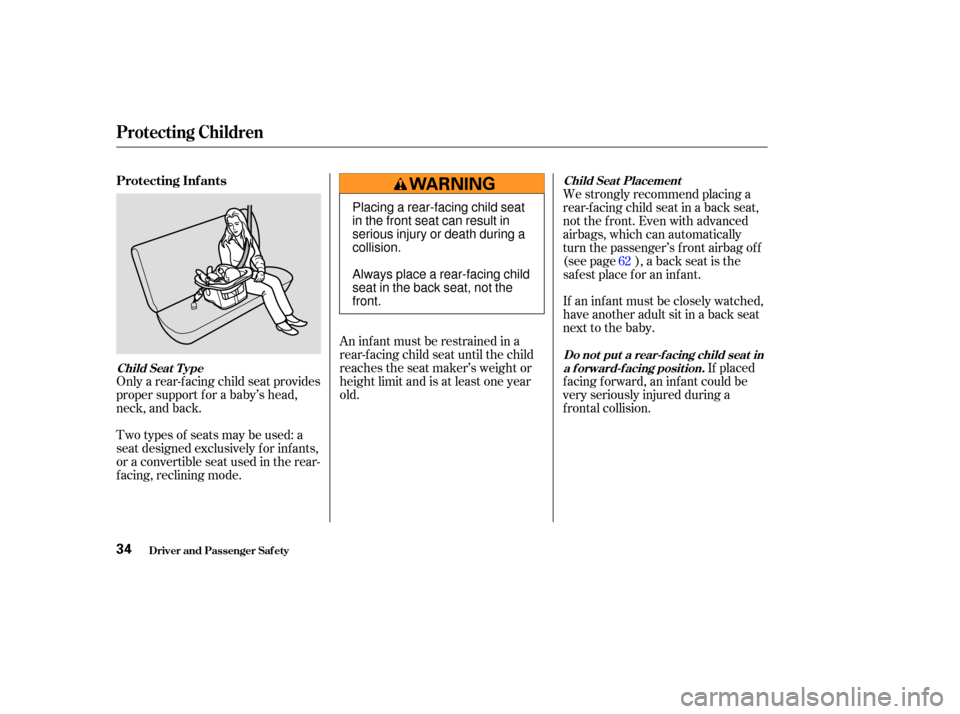
Only a rear-f acing child seat provides
proper support f or a baby’s head,
neck, and back.
Two types of seats may be used: a
seat designed exclusively f or inf ants,
or a convertible seat used in the rear-
f acing, reclining mode.An inf ant must be restrained in a
rear-f acing child seat until the child
reaches the seat maker’s weight or
height limit and is at least one year
old.We strongly recommend placing a
rear-facing child seat in a back seat,
not the front. Even with advanced
airbags, which can automatically
turn the passenger’s f ront airbag of f
(see page ), a back seat is the
saf est place f or an inf ant.
If an inf ant must be closely watched,
have another adult sit in a back seat
next to the baby.
If placed
f acing f orward, an inf ant could be
very seriously injured during a
f rontal collision. 62
Protecting Inf ants
Child Seat T ype Child Seat Placement
Do not put a rear-f acing child seat ina f orward-f acing position.
Protecting Children
Driver and Passenger Saf ety34
Placing a rear-facing child seat
in the front seat can result in
serious injury or death during a
collision.
Always place a rear-facing child
seat in the back seat, not the
front.
Page 38 of 415
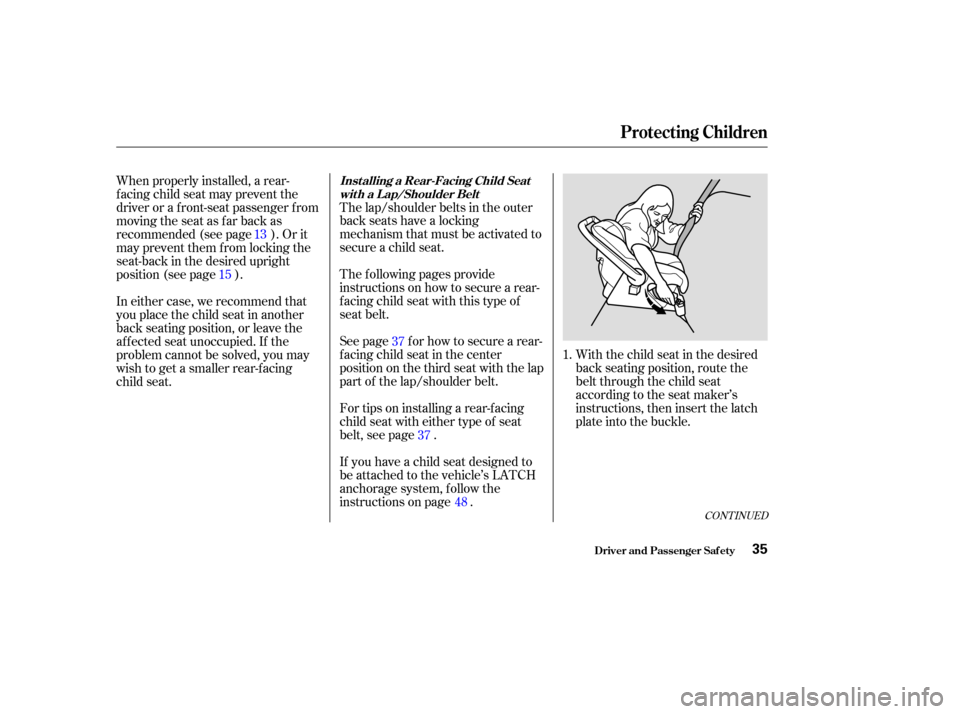
With the child seat in the desired
back seating position, route the
belt through the child seat
according to the seat maker’s
instructions, then insert the latch
plate into the buckle.
The lap/shoulder belts in the outer
back seats have a locking
mechanism that must be activated to
secure a child seat.
The f ollowing pages provide
instructions on how to secure a rear-
facing child seat with this type of
seat belt.
See page f or how to secure a rear-
f acing child seat in the center
position on the third seat with the lap
part of the lap/shoulder belt.
For tips on installing a rear-f acing
child seat with either type of seat
belt, see page .
When properly installed, a rear-
f acing child seat may prevent the
driver or a f ront-seat passenger f rom
moving the seat as far back as
recommended (see page ). Or it
may prevent them f rom locking the
seat-back in the desired upright
position (see page ).
In either case, we recommend that
you place the child seat in another
back seating position, or leave the
af f ected seat unoccupied. If the
problem cannot be solved, you may
wish to get a smaller rear-f acing
child seat.
If you have a child seat designed to
be attached to the vehicle’s LATCH
anchorage system, follow the
instructions on page .1.
13
15
3748
37
CONT INUED
Inst alling a Rear-Facing Child Seat
wit h a L ap/Shoulder Belt
Protecting Children
Driver and Passenger Saf ety35
Page 39 of 415
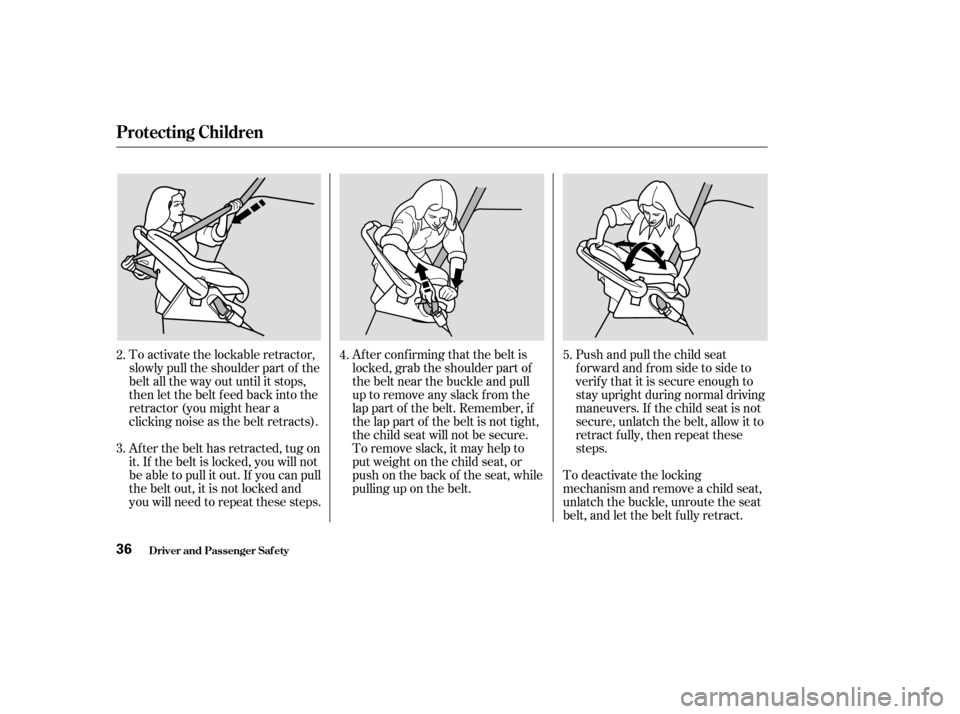
To activate the lockable retractor,
slowly pull the shoulder part of the
belt all the way out until it stops,
then let the belt f eed back into the
retractor (you might hear a
clicking noise as the belt retracts).
Af ter the belt has retracted, tug on
it. If the belt is locked, you will not
be able to pull it out. If you can pull
the belt out, it is not locked and
you will need to repeat these steps.Af ter conf irming that the belt is
locked, grab the shoulder part of
the belt near the buckle and pull
up to remove any slack from the
lap part of the belt. Remember, if
the lap part of the belt is not tight,
the child seat will not be secure.
To remove slack, it may help to
putweightonthechildseat,or
push on the back of the seat, while
pulling up on the belt.
Push and pull the child seat
f orward and f rom side to side to
verif y that it is secure enough to
stay upright during normal driving
maneuvers. If the child seat is not
secure, unlatch the belt, allow it to
retract f ully, then repeat these
steps.
To deactivate the locking
mechanism and remove a child seat,
unlatch the buckle, unroute the seat
belt, and let the belt f ully retract.
4.
3. 2. 5.
Protecting Children
Driver and Passenger Saf ety36
Page 40 of 415
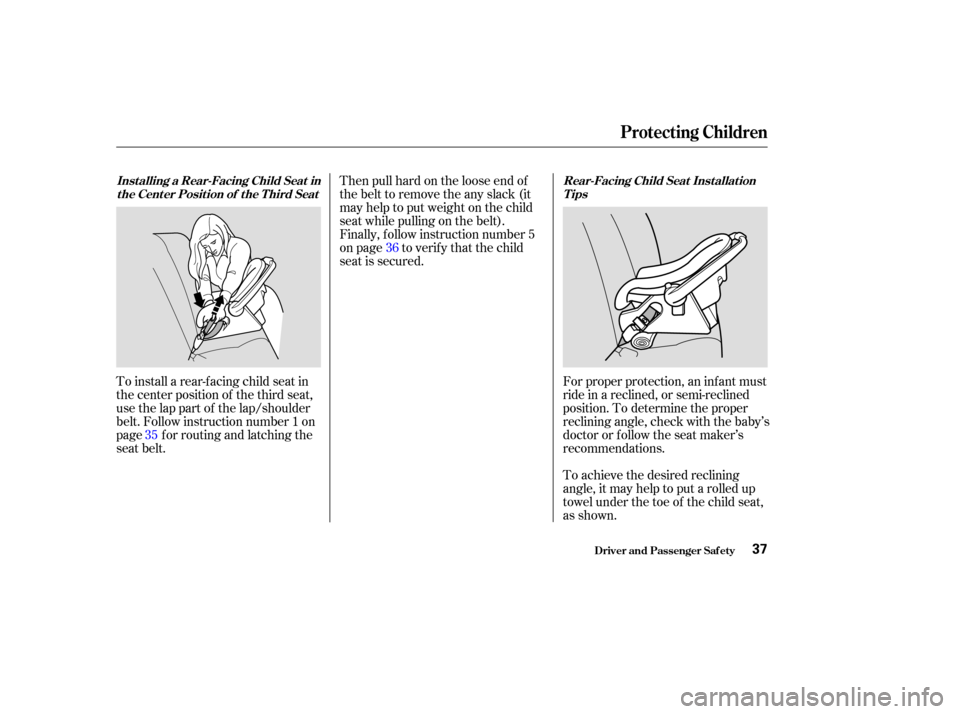
Forproperprotection,aninfantmust
ride in a reclined, or semi-reclined
position. To determine the proper
reclining angle, check with the baby’s
doctor or f ollow the seat maker’s
recommendations.
To achieve the desired reclining
angle, it may help to put a rolled up
towel under the toe of the child seat,
as shown.
Then pull hard on the loose end of
thebelttoremovetheanyslack(it
may help to put weight on the child
seat while pulling on the belt).
Finally, f ollow instruction number 5
on page to verify that the child
seat is secured.
To install a rear-f acing child seat in
the center position of the third seat,
use the lap part of the lap/shoulder
belt. Follow instruction number 1 on
page f or routing and latching the
seat belt. 35 36
Protecting Children
Driver and Passenger Saf ety
Rear-Facing Child Seat Inst allat ion
Tips
Inst alling a Rear-Facing Child Seat in
t he Cent er Posit ion of t he T hird Seat
37